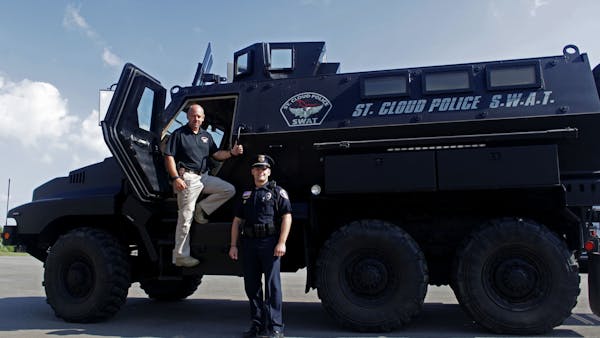Does the Grand Rapids, Minn., police department really need a grenade launcher? No, admits the police chief; and the problem now is trying to get rid of the one they have.
But to the sheriff of Sherburne County and to the police chief in Rochester, the grenade launchers they have actually serve a purpose: launching projectiles like tear gas in hostage situations and at times when a suspect might be barricaded.
If ordered to get rid of theirs because of a new White House directive about surplus military equipment, the leaders of the two departments say they would comply, and then go out and get new equipment they say they need to safely do their jobs.
Responding to mounting concerns about the over-militarization of the nation's police departments in the aftermath of disturbances in Ferguson, Mo., and Baltimore, President Obama announced plans this week to restrict law enforcement use of surplus military equipment. That will include grenade launchers, tracked vehicles, bayonets, and .50-caliber or stronger weapons and ammunition.
On the surface, the directive sounds severe. In reality, Minnesota law enforcement officials say they know of no department in the state with anything firing .50-caliber ammunition, or any agency with a tracked vehicle like a tank, or even any department with a single grenade.
According to data maintained by the Minnesota Department of Public Safety, seven law enforcement agencies in the state do have grenade launchers from a federal program that provides them from military surplus.
Rochester Police Chief Roger Peterson sees the two launchers his department as vital to his tactical arsenal, even if he can't recall a time when they were used. If ordered to return the two surplus grenade launchers, Peterson said he would lobby for procuring additional equipment.
"They are not high-ticket items, but we need them when we need them," he said.
Sherburne County Sheriff Joel Brott said the launcher his department has from the program was used in a domestic disturbance in which a woman had been shot and a man had barricaded himself inside the home. Police used the gun to safely fire tear gas into the house and disable the suspect. The department's old gas gun had been around since 1991 and was replaced in 2007.
Brott said the launcher is for a very specific purpose.
"We don't have it for anything else, we don't want it for anything else. It's a gas gun," he said.
The Minnesota Chiefs of Police Association said the changes provide a more formalized structure to acquire and return equipment, helping with accountability, but will have little impact on Minnesota agencies that have acquired other equipment like night-vision goggles and even extreme-weather trousers.
The association said proper training and enforcement will go further in maintaining relationships with citizens than having the equipment Obama has proposed restricting.
"We believe that how officers act is more important than how they are equipped," said the association's executive director, Andy Skoogman.
Getting rid of the stuff
Sometimes, the equipment can prove as much of a problem as a help.
The grenade launchers are part of more than 5,200 pieces of military equipment now in the hands of Minnesota law enforcement agencies through the federal surplus program.
Rifles and other weapons make up most of the equipment, including the more than 300 pistols agencies have been provided. Anoka County, for instance, has obtained 76 M16 rifles from the program over the years, according to state data.
There are also more visible acquisitions, like the 31 armored and mine-resistant vehicles.
Grand Rapids Police Chief Scott Johnson, who found himself inheriting the department's grenade launcher, said there is a misperception about how the equipment is most often used.
His 19-officer department is one of only two law enforcement agencies in Itasca County in northern Minnesota. If a major incident occurs, police must call in SWAT help from neighboring St. Louis County, which has a retrofitted Mine Resistant Ambush Protected (MRAP) vehicle.
"There is an example where surplus military use for law enforcement purpose is very needed," Johnson said, adding that equipment like MRAPs shouldn't be used for things like crowd control, as they were in Ferguson. "That MRAP, it can drive right up to the house, take down the front door, deliver gas through the living room window safely, so that you don't have police officers in harm's way."
Besides its grenade launcher, which the department obtained over 20 years ago but has never used, the surplus program has outfitted Grand Rapids police with Vietnam-era semi-automatic rifles.
The rifles have been replaced with more modern AR15s, which the department purchased on its own. But since the surplus equipment technically remains government property, it cannot be easily disposed of or sold for scrap. Chief Johnson now has a sergeant working on figuring out how to legally get rid of the stuff.
"The military is lending this to the municipalities, so we can't destroy it or sell it," Johnson said. "It's frustrating."
Mark Brunswick • 612-673-4434

An infamous heist put this North Woods town in the global spotlight. Nervous breakdowns and Hollywood deals ensued.

Edina sophomore two-sport standout on recruiting: 'Gotten a little busy'
![Greg Ketchum put a fresh crate of cherries out for sale at the Patnode's stand, which workers say is the oldest at the farmers market. ] ANTHONY SOUFF](https://arc.stimg.co/startribunemedia/PXAYPLUT6O67HYOFFC6PNPVTSM.jpg?h=91&w=145&fit=crop&bg=999&crop=faces)
